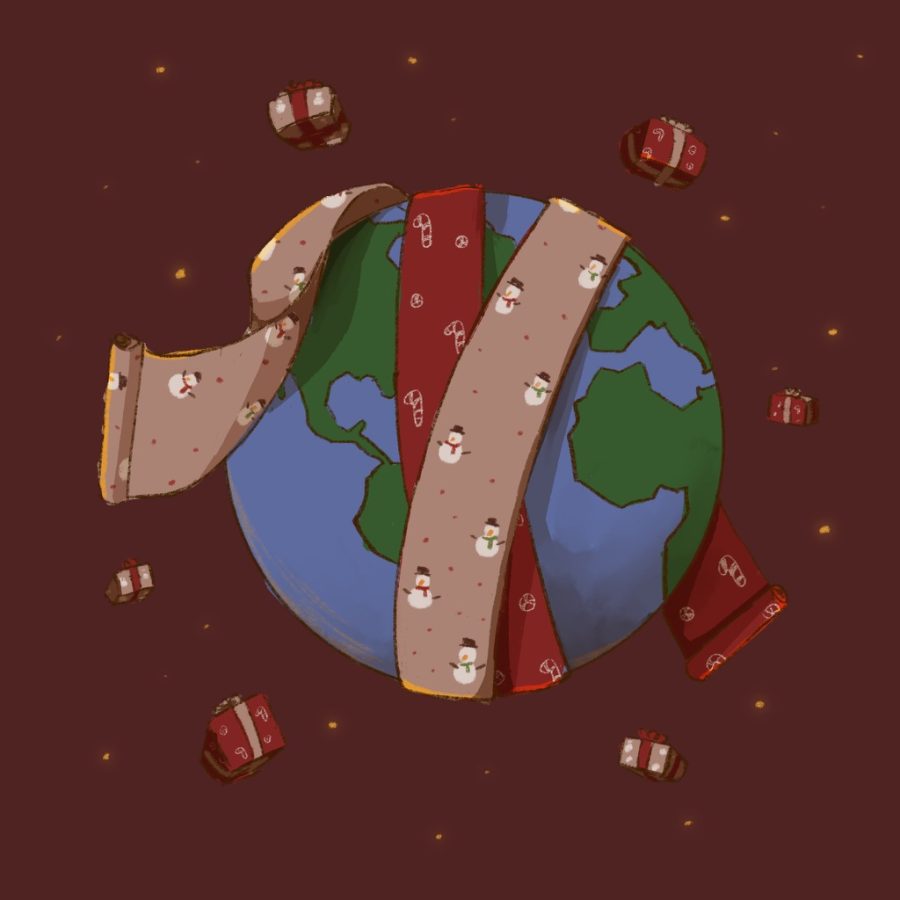The Wrap on Wrapping Paper
December 15, 2022
There are many things people think of when Christmas comes around: presents, snow days, a large Christmas tree, and some warm hot chocolate in front of the chimney. But people usually do not think about wrapping paper and the environment when they are full of holiday cheer. The tremendous pollution caused by wrapping paper is never covered in the news and the effects the trash has on the environment are also rarely talked about. This problem must be addressed especially because according to North London Waste Authority, “Approximately 11.8 million kilos of carbon dioxide are emitted each year just manufacturing Christmas wrapping paper.” The production itself is not even the biggest problem. Most of the pollution caused by wrapping paper is the paper itself. It cannot be recycled and must be thrown away as it uses many microplastics such as glitter. Even if the sparkly paper might be much more appealing, it cannot be recycled and is thrown in the trash and disposed of in landfills where they leave many microplastics vulnerable to flying away from the wind into our oceans. The problem with pollution is that the knowledge of the harm being done to the environment is not widely known or spread. Junior Cowan Cole says, “The pollution wrapping paper causes needs to be talked about more. I have not even heard about it at all.” The unpopular topic of pollution is one of the many problems during the holidays not to mention the astronomical usage of wrapping paper.
Changing production levels or costs is one idea and some argue that it is better than changing the amount produced, like freshman Sophia Castellese, who says, “Changing the amount of wrapping paper we [produce] would be better [than changing the amount we use].” According to the Oregon Environmental Council, “Approximately half of our paper use goes to one-time use wrapping and decorating,” which creates a lot of pollution as well, so limiting or lowering the quota of the colorful paper is another way to lower the amount in landfills and the carbon emissions. The usage of wrapping paper makes the issue of waste even worse, as during the holidays, the usage increases, and therefore the waste does as well. This makes the crisis of wrapping paper even worse as it is one of the most used things during Christmas. Limiting is a viable option especially because according to Stanford:“If every American family wrapped just three presents in re-used materials, it would save enough paper to cover 45,000 football fields.” Even a slight change could create such a large effect. Others argue for everyone to change their ways such as senior Anna Dennis who believes that “People are going to want to use wrapping paper no matter what.” If that is true, then instead of changing the amount of wrapping paper creating alternatives or using different materials to make the paper used could work. If people are going to use wrapping paper, they might as well use some that is better for the environment.
There are many ways to prevent the massive amount of wrapping paper being wasted. For example changing what part of the paper is causing pollution or the level of production itself. The wrapping papers material can be changed into paper that is much easier to recycle and or reuse. The Canadian Broadcasting Corporation “suggests recyclable brown paper, tied up with string.” Other options exist like using newspaper which can be easily recycled. There are also paper bags or plastic gift bags that are reusable, although they are not recommended as they cannot be recycled. Changing the minds of the people using wrapping paper might be hard, but media coverage of the crisis can also change the industry itself especially because many people use wrapping paper since they think that it is recyclable even though it is not. Many Issaquah High school students did not know that wrapping paper was not being recycled. Sophomore Mario Araujo states, “I did not know wrapping paper was not recyclable.” The lack of media coverage is a major problem in finding a solution for the upcoming wave of wrapping paper usage. This lack also limits the education and knowledge of others on this topic. If the true effects of wrapping paper were to be covered in the news it would reach many people and make many minds think more about what they are going to use to cover their presents this year.
Whether it is lowering production, increasing media coverage or changing what people use, there needs to be people who step forward and start the change that is desperately needed. Once people begin to take action, more will follow in the movement and true change can happen. Improving our environment’s health can be achieved even if it is just one step in the right direction.



